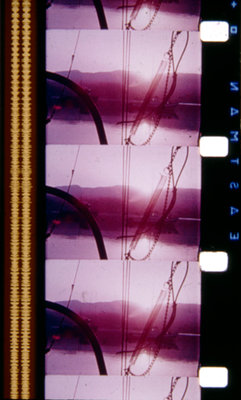
1963, USA, 16mm, colour, sound, 16 min.
…That was probably the first film where I felt I was starting to get a hold of the medium. There are some awkwardnesses, especially a few still cuts between trees, that remain disturbing to me, but for the most part it’s a pretty interesting tribute to Wagner and the myth of the Holy Grail and the Parsifalian hero.
I was out on a fishing boat, and I knew a new film was cooking in me and that it was spring and a tribute to the loveliness of spring was coming, and I heard this music on the boat and had my camera. An old friend, Willard Morrison of Audio Film Center, in San Francisco, had given me the first rolls of new color film I ever had, about seven rolls of the old Ektachrome - so beautiful. ASA 15 or 16. It was like liquid gold in my camera. Like silver bullets. I had a couple rolls of that with me, so I listened to the music coming in over a little speaker up on the mast as we rolled along in the Pacific Ocean off the Golden Gate - …and you could really feel the sea, and so I just shot it the way it was.
…You’re given a certain responsibility and a gift or grace, a certain unique capability, which can turn against you if it’s not attended to properly. Even the king who possessed this emblem of purity or perfection, this divine weapon, was heir to temptation, and the weapon fell into the hands of his nemesis. The wound was ultimately mortal. Though he was still alive, still functioning, he was incapable of carrying on this essential divine mission to celebrate Infinite Truth, embodied in the Holy Grail, so it was foretold that there would be a successor who would come along, a “pure fool” as Wagner called him - whether the original name was Parsifal or Percivil, it really meant pure fool.
Bruce Baillie
A Critical Cinema 2, interviewed by Scott MacDonald (June, 1989)
